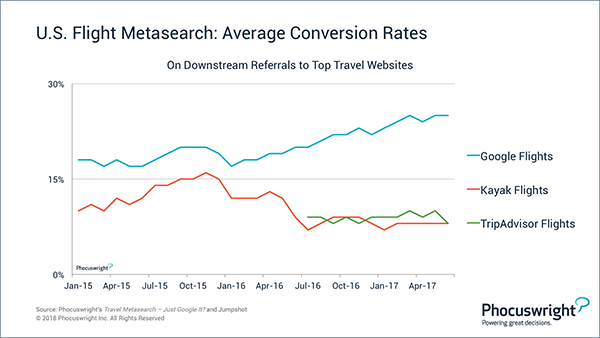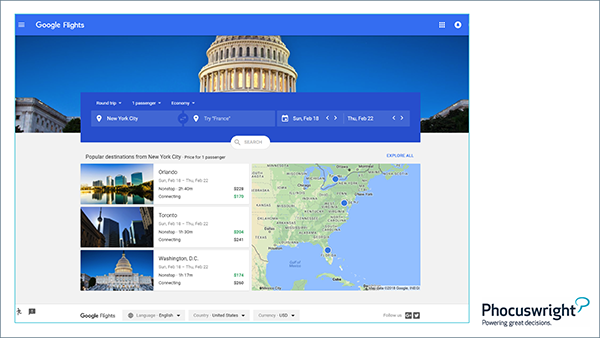Is Google Flights the OTA antidote?
- Published:
- February 2018
- Analyst:
- Alice Jong
Travel metasearch was initially built on the premise that travel suppliers needed a platform to compete against OTAs for the attention of bargain-hunting consumers. Suppliers have fared better at holding the stronger metasearch position in the more consolidated U.S. air segment than in the fragmented hotel market. However, when examining U.S. metasearch referral data from analytics firm Jumpshot to the top 15 downstream travel websites over the past two years, share of air referrals to OTAs has been rising and surpassed 50% share last year.
Suppliers have the definitive edge, however, when we consider Google Flights. Analysis of Jumpshot clickstream data over the first half of 2017 shows that four in five Google Flights referrals are to airline websites. Phocuswright research indicates that overall, travelers going to airline websites are more likely to convert than those going to OTAs. This also proves true with Google's metasearch travelers – the disproportionate share of Google Flights' referrals to suppliers is translating to notably higher conversion rates on its leads than other metasearch sites where OTAs get more referrals.

(Click image to view a larger version.)
Google Flights is speedily growing monthly visitors (it took them less than five years to surpass KAYAK despite KAYAK's eight-year head start to market), but fewer visitors are clicking onwards to airline or OTA websites. So, while Google may deliver conversions at a higher rate, it's delivering on smaller referral volume. KAYAK wins in the middle and generates more leads to downstream sites, leaving room for Google to bridge the gap between its two strengths.
Enter Google Flights' updated design. The company rolled out a new format in beta late last year that suggests a shift from "inspirational" to "let's-get-right-to-the-point." The new simplified homepage cuts down the "Discover Destinations" feature from displaying a lengthy laundry list of suggested places to just three recommendations. Reduced clutter means the flight search bar is featured more prominently, and all content is now above the fold. These moves position Google to better compete for those mid-funnel travelers where KAYAK currently leads, and encourage its existing base of window shoppers further down the funnel.

(Click image to view a larger version.)
If Google Flights can successfully drive a higher volume of referrals while maintaining its attractive conversion rates, then they just may be able to deliver on that original metasearch "OTA antidote" promise.
HOW TO LEARN MORE
- Attend
Phocuswright Europe to hear from Google's vice president, travel and shopping, Oliver Heckmann, on 17 May.



- Download Phocuswright's Travel Metasearch – Just Google It?, exclusively available for research subscribers.
- Access Phocuswright's U.S. Leisure Travel: Shopping and Booking, part of the U.S. Consumer Travel Report Ninth Edition series.
Not a subscriber? Check out the Open Access research subscription HERE.
Contact Us
Need something else? Our team is here to help you!
sales@phocuswright.com OR +1 860 350-4084 x501











